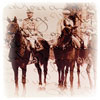Captain Alex James Kaine, MC, was born in Gorrie, Huron County, Ontario, on March 30, 1870, the seventh of ten children of parents John and Mary (née Pentland) Kaine. Prior to his enlistment in World War I, he worked as an immigration inspector, and had been a member of the Canadian Militia for almost twenty years.
Commissioned as a Lieutenant into the Army’s 8th Battalion, Canadian Expeditionary Force, (C.E.F.), he served as the First Contingent recruiting officer in Fort Frances, Ontario, and then as a training officer in Valcartier, Québec. Proceeding to England with the 8th Bn. on October 3, 1914, he remained in England with the C.E.F. until March of 1916 when he was discharged to serve in the British Army as a Lt. with the 2nd Battalion, Sherwood Foresters (Nottinghamshire and Derbyshire Regiment).
While serving with the Sherwood Foresters, Kaine was awarded the Military Cross on November 16, 1916. From The London Gazette (link below): “His Majesty the KING has been graciously pleased to confer the Military Cross on the undermentioned Officers and Warrant Officers in recognition of their gallantry and devotion to duty in the Field:— . . . Temp. Lt. Alex James Kaine, Notts. & Derby. R. For conspicuous gallantry in action. He gallantly led his company in attack. Later, with great skill and determination he consolidated the position won. He set a fine example.”
Health issues resulting from multiple wounds suffered while in action at the front led to his eventual discharge from the British Army in June of 1918. Kaine returned to Canada and settled in Fort Frances, Ontario.
The majority of the letters in the collection were written by Alex Kaine to his sister Robina (“Bina” or “Bi”) Kaine, who was working at the time as a schoolteacher in Sault Ste. Marie, Ontario. Several of the letters were written to Robina Kaine by Ada (last name unknown), a relative living in Knock, Dublin, Ireland. Alex stayed with Ada for several weeks while recovering from a gunshot wound in 1916. Also included is a biographical document written by Alex’s sister Robina describing some of his wartime experiences; this has been posted below under the “Memoir” content section.
External links:
Capt. Kaine’s service record (Serv/Reg# not assigned*) can be viewed/downloaded in pdf format through Library and Archives Canada.
The awarding of the Military Cross to Kaine was published in The London Gazette on November 16, 1916 (#13012, p.2081). He was granted the honorary rank of Captain upon leaving the British Army, as published on June 25, 1918 (#30769, p.7602).
*WWI officers were not routinely assigned Service/Regimental #s
[Editor’s Note: There are conflicting records regarding Kaine’s date of birth. The date given above is taken from his service record with Library and Archives Canada.]




